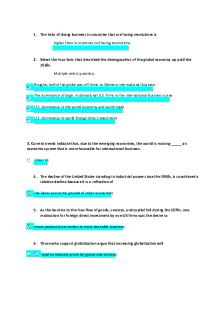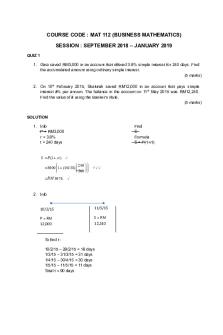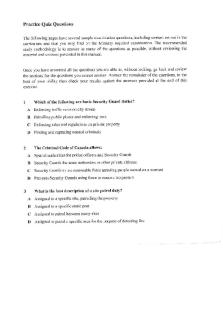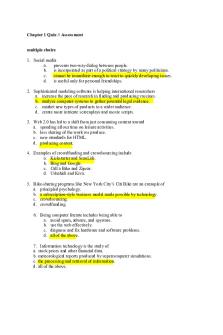MGT2381 Chapter 1 Practice Quiz PDF

| Title | MGT2381 Chapter 1 Practice Quiz |
|---|---|
| Course | Human Resources Management |
| Institution | Algonquin College |
| Pages | 6 |
| File Size | 107.5 KB |
| File Type | |
| Total Downloads | 105 |
| Total Views | 171 |
Summary
iii...
Description
Human Resources Management (Practice Quizzes) Chapter 1-A (Practice Quiz) 1) Number of job candidates interviewed per month and cost per hire are ____________ measures of HRM, while the quality of people and the effectiveness of HRM initiatives are ______________ measures of HRM. Answer: new; traditional 2) To ensure that the workforce has the competencies and behaviours required to achieve the organization's strategic objectives Answer: HR formulates and implements HRM systems.
3) A major contribution of HRM is making decisions based on evidence-based HRM. Answer: True 4) Analyzing metrics and measurements is a strategic HR activity. Answer: True 5) Employee engagement is the emotional and intellectual involvement of employees in their work. Answer: True 6) The management of people in organizations is referred to as Answer: human resources management. 7) Which of the following best describes the term productivity? Answer: The ratio of an organization's outputs to its inputs
8) The implied, enforced, or felt obligation of managers to serve or protect the interests of groups other than themselves is called Answer: social responsibility
9) Police departments, universities, and employers of skilled tradespeople are all experiencing difficulty finding qualified employees today as some of their staff retire. Which of the following might contribute to this difficulty? Answer: The large Baby Boomer group is followed by a smaller Generation X group.
10) A core HR competency is that of being both ________ (respected, listened to, trusted) and ________ (takes a position, challenges assumptions). Answer: credible; active
11) Sarah is employed as a computer analyst at Provincial University, a large government-funded postsecondary institution. What sector of the economy is Sarah employed in? Answer: Tertiary or service sector
12) Organizational benefits of human resources practices such as increased productivity result from Answer: employee empowerment and extensive training.
13) The process of analyzing manufacturing processes, reducing production costs, and compensating employees based on their performance levels is known as Answer: scientific management. 14) Which of the following is not a purpose of human resource management according to your text? Answer: Maximizing job creation
15) Which of the following high-performance HR practices have a positive relationship with turnover and corporate financial performance? Answer: Incentive compensation and employee performance management systems
16) The Canadian Council of Human Resources Association (CCHRA) is the national body through which all provincial HR associations are affiliated. Answer: True
Chapter 1-B (Practice Quiz) 1) More and more companies are realizing that human capital is Answer: the next competitive advantage. 2) Workers that do not fit the traditional definition of permanent, full-time employment with the same employer on an indeterminate basis are known as Answer: contingent workers.
3) The ______________-based view of the firm suggests that HR practices contribute to the development of company culture, history, process, and context. Answer: resource
4) The professionalism of HRM has created the need for a uniform Answer: code of ethics. 5) Few employers are changing how they organize their human resource functions. Answer: False 6) The practice of linking external opportunities or threats to organizational goals is called Answer: environmental scanning. 7) The growing integration of the world economy into a single, huge marketplace is increasing the intensity of competition and leading most organizations to expand their operations around the world. This is known as Answer: globalization. 8) Outsourcing involves contracting with outside vendors to handle specified business functions on a permanent basis. Answer: True
9) Bob loves his job, which involves attracting people through advertising and promotion to apply to work at his organization. What function of human resource management is Bob working in?
Answer: Recruitment 10) The HR Competency Model has nine functional areas. The teambased competencies include all of the following except Answer: total rewards. 11) Which functional department has the primary responsibility for managing the workforce that drives organizational performance and achieves the organization's strategic goals? Answer: Human resources department 12) The balanced scorecard is a measurement system that translates an organization's strategy into a comprehensive set of performance measures. Answer: True 13)
Knowledge, skills, training, education, and expertise are referred to as
Answer: human capital. 14) Today's HR professionals need to be able to measure the value and impact of their organization's human capital and HRM practices. The use of various metrics, or statistics, to measure the activities and results of HR is now quite common. Answer: True
15) There are six core capabilities/competencies for HR professionals to secure to help deliver value to the organization. Which of the following is not one of these competencies? Answer: Administration guru...
Similar Free PDFs

MGT2381 Chapter 1 Practice Quiz
- 6 Pages

Chapter 1 - quiz practice
- 5 Pages

Chapter 24 quiz - Practice Quiz
- 3 Pages

Chapter 7 Practice Quiz
- 19 Pages

Practice Quiz Chapter 3
- 6 Pages

Chapter 3 - quiz practice
- 5 Pages

Chapter 48 Practice Quiz
- 3 Pages

Sample Quiz #1 - Practice Quiz
- 2 Pages

Patho Practice Quiz 1
- 5 Pages

HW 1 - Quiz Practice
- 7 Pages

Practice Quiz 1
- 2 Pages

QUIZ 1 MAT112 Practice
- 2 Pages

Practice Quiz 1 - Exam
- 24 Pages

Practice Quiz 1
- 11 Pages
Popular Institutions
- Tinajero National High School - Annex
- Politeknik Caltex Riau
- Yokohama City University
- SGT University
- University of Al-Qadisiyah
- Divine Word College of Vigan
- Techniek College Rotterdam
- Universidade de Santiago
- Universiti Teknologi MARA Cawangan Johor Kampus Pasir Gudang
- Poltekkes Kemenkes Yogyakarta
- Baguio City National High School
- Colegio san marcos
- preparatoria uno
- Centro de Bachillerato Tecnológico Industrial y de Servicios No. 107
- Dalian Maritime University
- Quang Trung Secondary School
- Colegio Tecnológico en Informática
- Corporación Regional de Educación Superior
- Grupo CEDVA
- Dar Al Uloom University
- Centro de Estudios Preuniversitarios de la Universidad Nacional de Ingeniería
- 上智大学
- Aakash International School, Nuna Majara
- San Felipe Neri Catholic School
- Kang Chiao International School - New Taipei City
- Misamis Occidental National High School
- Institución Educativa Escuela Normal Juan Ladrilleros
- Kolehiyo ng Pantukan
- Batanes State College
- Instituto Continental
- Sekolah Menengah Kejuruan Kesehatan Kaltara (Tarakan)
- Colegio de La Inmaculada Concepcion - Cebu

